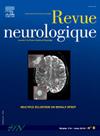在法国一家研究所,2019冠状病毒病大流行减少了胶质瘤患者护理途径的延误。
IF 2.3
4区 医学
Q2 CLINICAL NEUROLOGY
引用次数: 0
摘要
背景:据报道,在2019冠状病毒病大流行期间,癌症管理出现了延误。神经肿瘤患者是一个真正的挑战,因为他们的疾病可以在没有适当治疗的情况下迅速发展。然而,在这段时间内,这些患者的可用数据很少。因此,本研究的目的是研究COVID-19大流行对法国一家研究所特定人群治疗护理的影响。采用电子病历进行回顾性描述性研究。所有在2019年1月1日至2020年12月31日期间在神经外科部门接受神经胶质瘤手术的患者都被纳入研究范围。结果:114例脑胶质瘤患者行手术治疗;2019年(大流行前)为70例,2020年(大流行期间)为44例。在这些患者中,89%被诊断为高度胶质瘤,其中81%被诊断为胶质母细胞瘤。首次出现症状和成像过程之间的平均时间从2019年的35天增加到2020年的40天。然而,在护理途径的后续步骤中,每个阶段的时间表都有所改善,最多减少了4天。在两个特定的护理阶段,时间的减少具有统计学意义:(i)手术和组织分子诊断之间的间隔减少了两天,以及(ii)组织分子诊断和结果公告咨询之间的时间减少了三天。综上所述,2019年和2020年的平均首次治疗时间分别为术后49天和36天。结论:在法国某研究所,新冠肺炎疫情对胶质瘤患者的治疗护理途径产生了积极影响。虽然这种改善可以用几天来衡量,但这种护理的加速对研究人群来说仍然至关重要。本文章由计算机程序翻译,如有差异,请以英文原文为准。
The COVID-19 pandemic reduced delays in the care pathway for patients with glioma at a French institute
Context
Delays in cancer management have been reported during the COVID-19 pandemic. Neuro-oncology patients represent a real challenge as their disease can progress rapidly without appropriate care. However, data available for these patients over this period is scarce.
Objective
Therefore, the aim of this study was to examine the impact of the COVID-19 pandemic on therapeutic care within a specific population at a French institute. A retrospective descriptive study was conducted using electronic medical records. All patients who underwent surgery for glioma in a neurosurgery unit between January 1st, 2019 and December 31st, 2020 were included.
Results
A total of 114 patients were operated for a glioma; 70 patients in 2019 (before the pandemic) and 44 in 2020 (during the pandemic). Among these patients, 89% were diagnosed with a high-grade glioma, including 81% with glioblastoma. The mean time between first symptoms and imaging process increased from 35 days in 2019 to 40 days in 2020. However, in the subsequent steps of the care pathway, timelines improved at each stage with a reduction up to four days. The time reduction was statistically significant for two specific stages of care: (i) the interval between the surgery and the histomolecular diagnosis, with a reduction of two days, and (ii) the period between the histomoleculardiagnosis and the consultation for results announcement, with a reduction of three days. In summary, on average, the first treatment was initiated 49 days post-surgery in 2019 and 36 days post-surgery in 2020.
Conclusion
This study showed that the COVID-19 outbreak positively impacted the therapeutic care pathway of patients with glioma at a French institute. Although the improvement can be measured in days, this acceleration of care was nonetheless crucial for the population studied.
求助全文
通过发布文献求助,成功后即可免费获取论文全文。
去求助
来源期刊

Revue neurologique
医学-临床神经学
CiteScore
4.80
自引率
0.00%
发文量
598
审稿时长
55 days
期刊介绍:
The first issue of the Revue Neurologique, featuring an original article by Jean-Martin Charcot, was published on February 28th, 1893. Six years later, the French Society of Neurology (SFN) adopted this journal as its official publication in the year of its foundation, 1899.
The Revue Neurologique was published throughout the 20th century without interruption and is indexed in all international databases (including Current Contents, Pubmed, Scopus). Ten annual issues provide original peer-reviewed clinical and research articles, and review articles giving up-to-date insights in all areas of neurology. The Revue Neurologique also publishes guidelines and recommendations.
The Revue Neurologique publishes original articles, brief reports, general reviews, editorials, and letters to the editor as well as correspondence concerning articles previously published in the journal in the correspondence column.
 求助内容:
求助内容: 应助结果提醒方式:
应助结果提醒方式:


